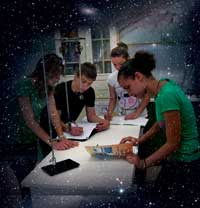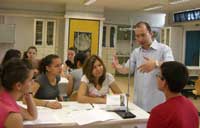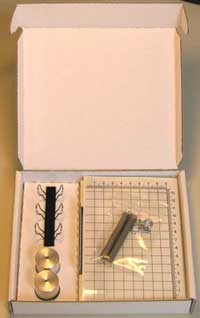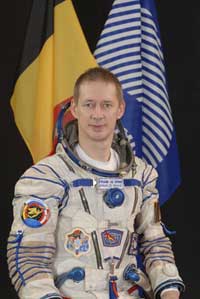A classroom in space Teach article
Lucy Patterson spoke to Greek science teacher Theodoros Pierratos, who recently won the chance to bring physics to life for his students in a truly extraordinary way with the help of the European Space Agency.

Pierratos and Carsten Przygoda
Theodoros Pierratos (aged 39) comes from a physics background and has been teaching science since 1998. He now teaches physics, astronomy and technology to 15- to 18-year-olds at the 2nd Lyceum of Echedoros, an upper secondary school in the western suburbs of Thessaloniki, Greece. He is also working towards a PhD thesis on physics didactics in the physics department of the Aristotle University in Thessaloniki.
Like many others, Theodoros feels that there is room for improvement in the way science is taught in schools. What especially concerns him is that, due to curriculum time constraints and a focus on preparation for university entrance exams, many teachers often end up abandoning the more experimental side of science teaching. He feels it is difficult for students to get inspired by science.
“Science is often taught in a way to make students believe that scientific discoveries are revealed to scientists in a magical way and last forever. Scientists themselves are thought to be extremely intelligent but antisocial people who work in secret underground laboratories. How could a student feel positive about this kind of science? We have to convince them that scientists are people like them and that they make mistakes like everybody does. Through hands-on activities that deal with real life, using trial and error methods, students will realise that science is everywhere: in playing football, when making a phone call, when cooking lunch. After all, I believe that we have to educate young people to be scientifically literate in order to make decisions about the future of our planet.”
Trying to keep in touch with the developments in science and science education, Theodoros spends a fair amount of his time visiting websites and reading journals. This is how he found out about the European Space Agency (ESA)w1 competition ‘Take your classroom into space’. “First I found the announcement on the ESA websitew2, and a few weeks later I read it in Science in School,” he says.
ESA invited European educators to propose new ideas for experiments to be carried out on board the International Space Station (ISS) (for more information on the ISS, see Hartevelt-Velani & Walker, 2008, and Hartevelt-Velani, Walker & Elmann-Larsen, 2008). Participants were asked to come up with original ideas that use the ISS to demonstrate the effects of gravity and free-fall to students.
Theodoros recognised that this was a fantastic opportunity to bring science alive for his students: to participate in a great space event and teach them basic physics in a truly remarkable way. The challenge then was to come up with an original idea.

physics class
Image courtesy of Theodoros Pierratos
“One day, as I was introducing the topic of oscillation to my 12th grade students, I asked them to imagine that they were on board the ISS, in a microgravity environment. What would happen if they pulled down a mass hooked to a spring and then let go? Many students answered that nothing would happen because there is no gravity! After many discussions with them, using known equations, the students finally managed to predict what would really happen: the mass will oscillate just as it would on Earth’s surface!”

space’ education kit
Images courtesy of ESA
Theodoros told his students about ESA’s competition and is especially proud that his students took up this chance, as the school has its difficulties: “There are many students who are immigrants. Some of them have language difficulties. In addition, many students come from low-income families; therefore, they lack stimuli and do not have easy access to resources.”
They formulated their proposal to ESA, entitled Objects do not weigh in space, so they have no mass: measuring the mass of an object in a zero gravity environment, which plays on students’ misconceptions about the ideas of weight and mass. It demonstrates two important ideas: firstly, that weight and mass are not the same, and secondly, that mass remains constant as we move from Earth’s surface into space. The students will also calculate the mass of an object at zero gravity.
When the announcement came that their proposal had won, they were, of course, thrilled. However, Theodoros’s involvement in the project was far from over. ESA consulted him on the technical development of the equipment to be taken aboard the ISS and asked to contribute to a booklet, written by teachers for teachers, introducing the two experiments which were selected to be carried out in space out of the five winning entries. You can download this teaching guide in seven languages and order an education kit onlinew2 that uses the same hardware that ESA astronaut Frank de Winne will use in orbit. The kits will be distributed for free to European teachers on a first-come, first-served basis.
Theodoros will also be integrally involved, along with his students, in the final event, hopefully with a live in-flight call to Frank de Winne on board the ISS. The experiments are scheduled to take place on 21 September 2009. The demonstration – a 20 minute broadcast live from the ISS – will be the highlight of a larger ground event dedicated to ‘Schools in space’.
This will connect the four hometowns of the five winning schools. For maximum impact, and to reach as many students as possible, the events will be hosted in a science centre in each host country (Belgium, Greece, Italy and Spain). In Greece, ESA has proposed the Thessaloniki Science Centre and Technology Museum. Shortly after the event, the broadcast will be made available on the ESA website.
“The high-quality level of interaction with ESA was a pleasant surprise to me. The communication with Dr Cristina Olivotto is frequent, particularly analytical and extremely friendly. ESA acts like we have been their collaborators for years. I have the feeling that I’ve got new friends in the Netherlands.”
For Theodoros and his students, the interaction with the ESA has been a boon for science teaching at his school.
“The students discovered that science can be exciting. ?hey feel so anxious about their experiments on the ISS that they remind me of the scientists at CERN who couldn’t wait for the LHC to start working [to read about the LHC, see Landua & Rau, 2008, and Landua, 2008]. When I suggested this to them, they replied that they feel as though they have in some way become scientists too! In science classes they’re not afraid to ask ‘What will happen if…?’; they defend their opinions, but can also change them, and they have realised that the only way to decide whether something is correct is to run the experiment.”
The experience also opened his students up to the possibility of further collaboration and involvement in other European initiatives, which they previously didn’t think feasible. This year alone, they have participated in an eTwinningw3 astronomy project and, together with eight other European schools, submitted an application to the European Commission’s Comenius partnership programmew4. As Theodoros says, “All of this happened after the engagement with the ESA’s competition. I am sure that the students are going to gain even more through their active participation in the forthcoming space event.”

Image courtesy of ESA
However, not many teachers and students are aware of the opportunities that ESA offers, at least in Greece: “Recently at a pan-Hellenic conference on science education, I presented a teaching module my colleagues and I had developed using ESA’s DVD series to introduce Newton’s law. No one attending the conference was aware of this excellent educational material, which is a real pity. Most of them were pleased to learn about ESA’s websitew1 where such material can be found.
“I realise that my students and their families now see school in a different way; until recently they thought school was boring or just an examination centre. Now they know that school is much more. I think this was achieved through this experience and I’m very pleased as a teacher.”
Theodoros also believes that, for his students, this experience has opened their eyes, and they now realise that they really have the option of considering science as a career.
“Many of my students who have positive feelings towards science are concerned that there are very few possibilities to pursue a science career in Greece. Most of them overlook the possibility of working in another European country. I think that projects such as ESA’s competition and the participation of schools in European partnership programmes (such as eTwinning and Comenius) could give them a better idea about what scientists really do: they use state of the art technology, they come across people from all over the world, and they travel a lot – so their job is far from routine. Moreover, learning about young scientists, their work and their life, can be inspiring for students.”
On a personal level, for Theodoros, the collaboration with the ESA has also given him the chance to satisfy a life-long dream.
“Of course it would have been even better if I was an astronaut on board the ISS, but, since I am not trained for this, I’m not complaining. So I think that the competition was a great chance for me to take myself into space in an unexpected way!”
Materials offered by ESA
The European Space Agency (ESA) is an international organisation responsible for co-ordinating the efforts of its member states in programmes designed to find out more about Earth, its immediate space environment, our solar system and the Universe. Education is a high priority for ESA. They are aware that the ideas of human spaceflight, the ISS and space in general hold a certain fascination for young people, and try to capitalise on this to foster an interest in science and technology, in the hope that it will encourage more students to study and consider careers in these subject areas. To achieve this, they support science teaching by producing a range of educational materials for primary, secondary and university students, as well as providing unique hands-on opportunities for students such as experiments to be carried out on board the ISS or a microgravity airplane.
To support science, technology, engineering and mathematics (STEM) education on a national basis, ESA has installed ESEROs (European Space Education Resource Office) and contact points in the Netherlands, UK, Belgium, Spain, Norway and Ireland. They use and disseminate existing ESA/ESERO education materials, and if appropriate, develop specific resources tailored to the needs of the local education community. The ESEROs also organise national ESERO teacher conferences for secondary and primary education.
To find out more about educational materials and opportunities offered by ESA, visit their education portal onlinew5.
References
Hartevelt-Velani S, Walker C (2008) The International Space Station: a foothold in space. Science in School 9: 62-65.
Hartevelt-Velani S, Walker C, Elmann-Larsen B (2008) The International Space Station: life in space. Science in School Issue 10: 76-81.
Landua R (2008) The LHC: a look inside. Science in School 10: 34-45.
Landua R, Rau M (2008) The LHC: a step closer to the Big Bang. Science in School 10: 26-33.
Web References
- w1 – To visit the ESA human spaceflight education website, see: www.esa.int/esaHS/education.html
- w2 – You can find more information on the ‘Take your classroom into space’ competition, download the teacher booklet and order kits here: www.esa.int/esaHS/SEMNDV0OWUF_education_0.html
- w3 – To learn more about the eTwinning project, see: www.etwinning.net
- w4 – You can find information on the European Commission’s Comenius programme here: http://ec.europa.eu/education/lifelong-learning-programme/doc84_en.htm
- w5 – Find out more about ESA education here: www.esa.int/SPECIALS/Education
- www.esa.int/SPECIALS/ESERO_Project/SEMMHT4KXMF_0.html
- www.esa.int/SPECIALS/ESERO_Project/SEM0LW4KXMF_0.html





